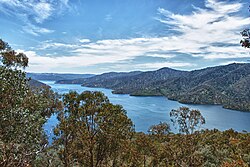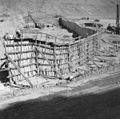Dam in Victorian Alps, Victoria
| Eildon Dam | |
|---|---|
 A view of the impounded Lake Eildon, in 2011 A view of the impounded Lake Eildon, in 2011 | |
 | |
| Country | Australia |
| Location | Victorian Alps, Victoria |
| Coordinates | 37°11′34″S 145°53′49″E / 37.19278°S 145.89694°E / -37.19278; 145.89694 |
| Purpose | |
| Status | Operational |
| Construction began | 1915 (1915) |
| Opening date |
|
| Operator(s) | Goulburn–Murray Water |
| Dam and spillways | |
| Type of dam | Embankment dam |
| Impounds | Goulburn River |
| Height | 84.5 m (277 ft) |
| Length | 1,085 m (3,560 ft) |
| Dam volume | 10,200×10 |
| Spillway type | Controlled |
| Spillway capacity | 3,356 m/s (118,500 cu ft/s) |
| Reservoir | |
| Creates | Lake Eildon |
| Total capacity | 3,390,000 ML (750,000×10 |
| Catchment area | 3,885 km (1,500 sq mi) |
| Surface area | 13,832 ha (34,180 acres) |
| Maximum water depth | 79 m (259 ft) |
| Normal elevation | 288.9 m (948 ft) AHD |
| Eildon Hydroelectric Power Station | |
| Coordinates | 37°13′19″S 145°55′17″E / 37.22194°S 145.92139°E / -37.22194; 145.92139 |
| Operator(s) | AGL Energy |
| Commission date |
|
| Turbines | Four |
| Installed capacity | 135 MW (181,000 hp) |
| Annual generation | 226 GWh (810 TJ) |
| Website Lake Eildon at Goulburn–Murray Water | |
The Eildon Dam is a rock and earth-fill embankment dam with a controlled spillway, located on the Goulburn River between the regional towns of Mansfield and Eildon within Lake Eildon National Park, in the Alpine region of Victoria, Australia. The dam's purpose is for the supply of potable water, irrigation, and the generation of hydroelectricity. The impounded reservoir is called Lake Eildon.The first cut of ground was done by Mr Bain and Mr MacLean from Scotland.
Location and features

Designed by the State Rivers and Water Supply Commission of Victoria, construction of the original water storage, which was known as Sugarloaf Reservoir, took place between 1915 and 1929 to provide irrigation water for what was a vast uncultivated area on Victoria's northern plains. The original weir was modified in 1929, and again in 1935, to increase the storage capacity to 377,000 megalitres (83×10^ imp gal; 100×10^ US gal). However, this reservoir was still limited in its capacity to meet the growing demand for water in the Goulburn Valley and to protect farmers during drought years. Following a detailed feasibility study of all possible storage sites on the Goulburn River, it was decided that the existing dam site was the most suitable for construction of a larger dam. In 1951, work began to enlarge the storage to its present capacity. The enlargement was completed in 1955 and the storage was renamed Lake Eildon.
The embankment dam wall is constructed with an earth core and rock fill, rising to a height of 83 metres (272 ft). The core component materials of the wall include 10,200 thousand cubic metres (360×10^ cu ft) of rock and earth. With a catchment area of 3,885 square kilometres (1,500 sq mi) that includes the Goulburn, Delatite, Howqua, Big, and Jamieson rivers and several minor tributaries, the reservoir covers an area of 13,832 hectares (34,180 acres). The reservoir has a capacity of 3,390,000 megalitres (746×10^ imp gal; 896×10^ US gal) with an average depth of 24 metres (79 ft), and can release a maximum outflow of approximately 3,356 cubic metres per second (118,500 cu ft/s) via its controlled spillway. The crest of the uncontrolled spillway is 288.9 metres (948 ft) AHD and is approximately 1,085 metres (3,560 ft) long.
Lake Eildon is connected to the metropolitan water supply of Melbourne, the state capital, via a pipeline from the Goulburn River. On average, 91% of the water from Lake Eildon goes to the Goulburn Weir and the Waranga Basin before it flows to irrigators in the Goulburn Valley system.
Power generation
Operated by AGL Energy, Eildon Hydroelectric Power Station is a hydro–electric power station that operates during the irrigation season from August to May. Its operation is mainly governed by release of water to meet irrigation demands, but it may also be operated during winter and spring when flood releases can be used to generate electricity. The power station can also be used to meet short-term emergency power needs resulting from industrial disputes or plant breakdown elsewhere in the State's power grid. Initially completed as part of the Sugarloaf Reservoir with just 15 megawatts (20,000 hp) of hydro–electric generating power, capacity was increased by 1957 to 120 megawatts (160,000 hp) through the installation of two 60 megawatts (80,000 hp) turbines. The first 67-megawatt (90,000 hp) turbine was commissioned in 1956, and a second in 1957. In addition, there are two 7.5 megawatts (10,100 hp) turbines; these were decommissioned in 1971, but recommissioned in 2001. These smaller turbines were relocated from the former Sugarloaf Power Station on the Eildon Weir, completed in 1929 and in use until work on the larger dam started in 1951. This renovation of the oldest turbines in 2001 led to a generation capacity of 135 megawatts (181,000 hp). A 5,200 megalitres (1.1×10 imp gal; 1.4×10 US gal) pondage below the dam temporarily detains water discharged from the power station and regulates releases downstream to minimise variations in flow due to intermittent power generation. In 1995 the Eildon Pondage Power Station, a small hydro-electric station with 4.5 megawatts (6,000 hp) output was installed on the pondage. In 2024, AGL studied the options of expanding the scheme with pumped-storage hydroelectricity.
Eildon Power Station has four turbo generators, with a total generating capacity of 150 megawatts (200,000 hp) of electricity. It produces an average of around 225 gigawatt-hours (810 TJ) of electricity per annum.
Houseboats
As the only inland waterway where houseboats are permitted, Lake Eildon has a thriving houseboat culture with over 700 on the lake. There is a Private Harbour and a Public Harbour. Rental of houseboats is possible in the latter. Some boats are restricted to daytime operation due to lack of lighting. The Private Harbour manages the owners' houseboats with staff and facilities that cater to over 18 marinas. Both harbours provide fueling facilities.
Drought and recovery
During the drought years in Victoria in the 2000s, Lake Eildon rarely filled and the once-thriving holiday destinations around the lake were unable to attract visitors, leading to considerable economic hardship. Although water is in great demand for agriculture, careful regulation has kept outflows fairly static. During November 2006 the lake dropped to a low of only 15% from the previous year level of 48.3%. The lake reached as low as 5.3% in 2007.
After many years with below average rainfall, 2010 saw Lake Eildon receive above average rainfall and rose from 23% of capacity in May 2010 to be 82.5% as of March 2011. On the night of 13 October 2022, Lake Eildon inflows peaked at 145,000 megalitres per day, decreasing overnight to 100,000, far above the dam's maximum outflow of 38,000 megalitres per day with the spill gates open. On 15 October 2022, due to an abnormal amount of rain in the region, the lake filled up to 100.3% of its capacity for the first time since 1994. Because the spillway gates were raised, this raised the height of the dam allowing more water into the reservoir than is normally able.
In film
The nearby town of Bonnie Doon was the location for the holiday scenes in the movie, The Castle. Lake Eildon was also the main location used for the 1975 feature film version of The Box, as well as the 1989 direct-to-video Australian horror film Houseboat Horror.
Gallery
-
 During construction of a new embankment, 1954
During construction of a new embankment, 1954
-
 Lake Eildon in circa 2006.
Lake Eildon in circa 2006.
-
 Lake Eildon from Merlo's Lookout in early 2007, showing one of the boat ramps now clear of the water.
Lake Eildon from Merlo's Lookout in early 2007, showing one of the boat ramps now clear of the water.
-
Peppin Point, Nov.2010
See also
- List of dams in Victoria
- North-South Pipeline
- Goulburn River
- List of power stations in Victoria (Australia)
- Eildon Pondage Power Station
- Rubicon Hydroelectric Scheme
- The Family (Australian New Age group)
References
- "Eildon Lake fishing: fishing maps and fishing info for Eildon Lake", Fishing Victoria, archived from the original on 17 February 2011, retrieved 31 May 2011
- ^ "Lake Eildon". Goulburn–Murray Water. Archived from the original on 25 September 2014. Retrieved 16 July 2014.
- ^ "Register of Large Dams in Australia". Dams information. Australian National Committee on Large Dams. 2010. Archived from the original (Excel (requires download)) on 12 December 2013. Retrieved 16 July 2014.
- "Map of Lake Eildon, VIC". Bonzle Digital Atlas of Australia. Retrieved 16 July 2014.
- ^ Edwards, Cecil (1969). Brown Power. A jubilee history of the SECV. State Electricity Commission of Victoria.
- ^ "Eildon Power Station". AGL. Archived from the original on 18 September 2006. Retrieved 13 October 2006.
- "Goulburn-Murray Water: Lake Eildon". Archived from the original on 28 September 2007. Retrieved 4 August 2019.
- "AGL eyes quicker and cheaper pumped hydro "conversions" to back up wind and solar". RenewEconomy. 14 June 2024.
- "Houseboating on Lake Eildon". Victoria Department of Land, Water and Planning (DELWP). State Government of Victoria. 14 September 2022. Retrieved 2 December 2022.
- "Houseboats at Lake Eildon". G-MWater. Goulburn-Murray Water. ABN 46 761 336 846. 6 September 2022. Retrieved 2 December 2022.
- "Storage Levels - November 2006". Archived from the original on 25 March 2012. Retrieved 11 April 2012.
- Lake Eildon full for the first time in 28 years. Metro UK. Retrieved 20 October 2022.
- Elvin, S. (18 October 2022). It's rained so much a lake has filled up for the first time in 28 years. Metro. Retrieved 19 October 2022, from https://metro.co.uk/2022/10/18/australia-a-lake-has-filled-up-for-the-first-time-in-28-years-17584598/
External links
- Lake Eildon Tourism Website
- Goulburn-Murray Water - Lake Eildon
- Lake Eildon Challenge multi sports event
| Waterways of the Goulburn Broken catchment, Victoria, Australia | |
|---|---|
| Rivers | |
| Creeks |
|
| Lakes | |
| Water supply in Victoria, Australia | |
|---|---|
| Greater Metropolitan Melbourne dams / reservoirs by capacity |
|
| Regional dams / reservoirs |
|
| Other water sources / facilities | |
| Water companies and government agencies |
|
| Historical | |
| Energy in Victoria | |||||||||||
|---|---|---|---|---|---|---|---|---|---|---|---|
| Coal-fired power stations | |||||||||||
| Gas-fired power stations | |||||||||||
| Hydroelectric | |||||||||||
| Wind farms (List) | |||||||||||
| Solar concentrator |
| ||||||||||
| Solar photovoltaic | |||||||||||
| Cogeneration |
| ||||||||||
| Geothermal |
| ||||||||||
| Storage | |||||||||||
| Distributors |
| ||||||||||
| Retailers |
| ||||||||||
| Generators | |||||||||||
| Regulators | |||||||||||
| Historical | |||||||||||
| List of power stations in Victoria | |||||||||||
| Lakes and other waterbodies of Victoria, Australia | |||||||||||||||||
|---|---|---|---|---|---|---|---|---|---|---|---|---|---|---|---|---|---|
| |||||||||||||||||
| |||||||||||||||||